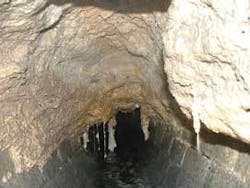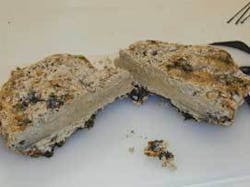WRc study examines FOG issues
An effective program to reduce the presence of fats, oils and greases (FOG) in sewers requires a comprehensive examination of many issues - legal, sociological, biological/ chemical, and operational. Dr. Kim Littlewood of the UK consultancy WRc reports on a major research project that will help in developing a FOG reduction program.
In Fall 2005, the WRc Sewer Operations section of WRc launched a large project that examines fats, oils and greases (FOG) in sewers. Currently, ten major water utilities in the UK support the project, which is being run under the Research Foresight Partnership.
Fats, oils and greases cause problems for sewerage utilities in a number of ways; flow inefficiencies, sewer-cleaning costs, build up at pumping stations, inlet works and treatment works, and the associated costs and serviceability consequences. Fats, oils and greases also cause sewer blockages in small-diameter pipes. Similarly, fats and grease present in sewers can significantly increase sediment build-up in small- and large-diameter sewer pipes.
The WRc project will carry out a total review of the issues associated with FOG. Researchers will examine the problem of FOG using four interconnected Work Packages, which will study the potential for operational solutions; biological and chemical solutions; sociological solutions; and legal solutions. The interaction between these solutions will be the most important aspect of the project. While the problems caused by FOG are significant, the causes and interaction between the effect of legislative, sociological and biological/chemical aspects are poorly understood. Furthermore, the role that these aspects would play in any future engineering/operational solution remains far from clear. An example of the way that the issues interact is the effect of the Landfill Directive on peoples’ disposal habits, and in particular, the disposal of fats oils and greases. Therefore, it became apparent that there is a need for a coordinated investigation of FOG issues. History suggests that, for this to be successful, it would be necessary to first consider the wider issues and not just focus upon one specific technical aspect.
FOG is a major cause of sewer flooding, both directly and indirectly. For example, blockages caused 55% of sewer flooding, accounting for more than 3,000 property-flooding incidents in the UK. Even when FOG compounds cause few problems in the sewer system, they can result in serious difficulties at sewage pumping stations and at the inlets to treatment works. The total cost of dealing with these various FOG-related issues is significant and is often the largest single item of sewer system operational expenditure. In this respect, an estimated £25 million (US$44m) is spent annually on reactive blockage clearance nationwide with further costs for clean up after flooding incidents. Regulators have commented that: “Sewer flooding remains an area of service where further significant improvement is needed and it remains a high priority for customers.”
FOG sources are many, but one of the largest sources is thought to be from the discharge of food and industry waste. The problems often appear greatest where sewer systems serve a proportionally high number of catering establishments; however some proportion of FOG comes from domestic users, and socio-economic factors play a part in how much FOG goes to the sewer from each household. Furthermore, recent changes in waste disposal legislation are likely to make the disposal of fats and other wastes more difficult, thereby creating a greater temptation to “fly-tip” these compounds into the drain.
The four aspects of understanding FOG in sewers are legal, sociological, biological/ chemical, and operational.
Legal issues
The water industry needs a critical analysis of the current legal framework that controls the disposal of FOG wastes. The legal situation in regards to FOG is unclear and significant legislative tension on FOG issues remains. Some of the issues that need to be clarified are:
• Can customers reasonably be fined for disposing of FOG down the sewer?
• What are the impacts of current and possible future waste disposal regulations?
• What are the alternate disposal routes and what impact will future legislation have on these?
• What is the potential impact of individual pieces of legislation such as the Streetworks Act?
A link between recent changes in waste disposal legislation and the likely impact on FOG problems in the sewer system is evident. Local authorities are under pressure to reduce the amount of waste that they dispose in landfills, and one of the recommendations that is currently being made by a local authority is that sloppy food waste should be disposed of “down the sink.” Sloppy food waste may cause blockages in the drains or sewers, and may contain a significant proportion of fat, exacerbating the FOG problem, but the local authority has targets to meet. In order to create a “win/win” situation, WRc needs to investigate whether there are alternatives to current disposal, and whether legislation will have an impact on these, for example, how the biodiesel market may be used to mitigate against FOG disposal problems and whether there are legislative barriers to increasing the biodiesel market.
Sociological issues
People’s behavior will always have an impact on issues such as what goes down the drain. This aspect of the project will be looking at FOG sources, and the reasons explaining why FOG is disposed into the sewer system. What are the drivers and tensions that make the sewer the easier place to dispose of FOG? In order to change people’s behavior, WRc researchers are examining existing alternatives and how these alternatives can be made more attractive. A number of key questions associated with public behavior follow:
• What is the public perception of disposal of fats to the sewer, and how could this be changed?
• What drivers can be used to reduce the disposal of FOG to sewers? Drivers are likely to include the provision of economic alternatives, such as collection for recycling, or developing ways to make the reuse of oils economic, for example the biodiesel approach.
• What are the drivers for the catering industry on reduction/redirection of FOG disposal? This could include dealing with the proper disposal of fats in catering and food hygiene courses.
• Is there potential for a framework for national leafletting campaigns and coordinated efforts at changing behavior countrywide? For example, a significant aspect of this could be the development of material for schools and encouraging the inclusion of such issues in environmental awareness related education. This would build on successful national campaigns such as “Bag It and Bin It.”
Biological/chemical issues
A number of biological and chemical compounds on the market claim to break down FOG and keep drains and sewers clear. Some of these are used by the water industry, but with mixed results. The industry needs a fundamental understanding of these solutions, including how they work, whether biological or chemical solutions will break down FOG, and circumstances under which these compounds work best. The key issues here are:
• Fundamental research into the components of the compound referred to as FOG. Does it contain, or is it affected by, road salts or dishwasher salts? Does it change by area (for example, are there ethnic effects on composition? Does it contain starch, gelatine or washing powder compounds? How far down the drain does it start to solidify? What temperature does it solidify at? This part of the project will be carried out as an EPSRC studentship.
• Examination of the biological solutions for dealing with the FOG problem. This should include examining the wide range of solutions currently being marketed to better understand chemical/biological processes involved and the by-products produced.
• Ascertaining the operation constraints and requirements for biological solutions, including understanding solutions that will work best in parts of the sewer system.
• A review of chemical solutions. However, it is unlikely that many chemical solutions will gain widespread use, as their effect on biological processes in sewers, sewage treatment works, and the wider environment is considered to be too great. Accordingly, a greater understanding of any chemical solution by-products will be necessary.
Operational issues
Operational solutions to clean FOG problems exist, but these may be affected by legislation, such as the Streetworks Act, making them uneconomic. The effectiveness of these solutions needs to be examined, including the ways in which these solutions may interact with chemical and biological solutions. This effort will include the design of sewers, wet wells, detention tanks and inlet works. The effect of different types of construction materials will also be taken into account. Are clay pipes less susceptible to FOG build up than concrete pipes, for example, or are brick structures a particular problem? Some key operational issues are:
• What is the scope for operational solutions, including working with contractors to ascertain best practices for cleaning and removal? This will include looking at new methods of applying biotech solutions in the sewer system or pumping station or inlet works.
• What could be done to improve operational practices to reduce fat build up in wet wells and inlet works?
• What will be the impact of food macerators and garbage grinders on the composition of wastes and their effect on fat contents in sewers?
• What is the potential for the use of fat traps on lateral drains/sewers serving high-risk FOG sites (catering establishments. etc)?
All of these aspects are interlinked, so people’s habits will be linked to changes in legislation and provision of alternatives. Additionally, sources of FOG change over time.
The potential benefits of a FOG reduction program will be wide ranging. First, there will be a reduction in the volume of sewer cleaning and blockage clearance, with a consequent reduction in associated operational costs. The next benefit will be a reduced risk of sewer blockages caused by FOG, and consequent reduction in flooding, with fewer customer complaints due to serviceability and blockages. However, one of the key issues with a project such as this one will be ensuring that solutions are implemented and that work carried out within the industry gains momentum. This project, currently supported by seven utilities, offers a good chance to make some significant changes across the industry.
Author’s Note
Kim Littlewood is a chartered civil engineer and head of sewer operations at WRc plc, who specializes in urban drainage. Dr. Littlewood is directly responsible for the development of the sewer operations area at WRc, developing research programs in conjunction with water industry clients. She is a consultant to the UK government on the review of drainage provisions of the building regulations and has continued involvement on research in support of sanitation provisions of the building regulations as a major partner in a research consortium. Recent projects include the £750,000 Fats, Oils and Greases project, “Wastewater in New Developments,” and Highway Drainage.



